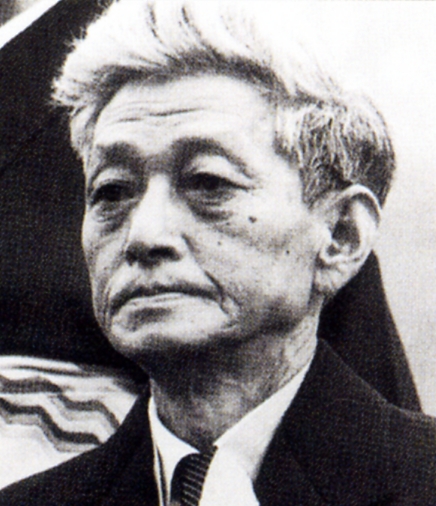- Hideo Kobayashi
Infobox Writer
name = Hideo Kobayashi

caption = Kobayashi Hideo
birthdate = birth date|1902|4|11|df=y
birthplace =Tokyo ,Japan
deathdate = death date and age|1983|3|1|1902|4|11|df=y
deathplace =Kamakura, Kanagawa ,Japan
occupation = Literary critic
genre = literary criticism
movement =
notableworks =
influences =Yasunari Kawabata ,Riichi Yokomitsu ,Okawa Shumei .
influenced = nihongo|Hideo Kobayashi|小林秀雄|"Kobayashi Hideo"|extra=11 April 1902 –1 March ,1983 was aJapanese author , who establishedliterary criticism as an independent art form inJapan .Early life
Kobayashi was born in the
Kanda district ofTokyo . He studiedFrench literature atTokyo Imperial University and graduated in 1927.Chuya Nakahara was one of his friends then.Literary critic
In the early 1930s he was associated with the novelists
Yasunari Kawabata andRiichi Yokomitsu and collaborated on articles for theliterary journal "Bungaku-kai " and became editor in 1935. At that time Kobayashi felt literature should be relevant to society, with writers and critics practicing social responsibilities. His editorials covered a wide range from contemporary literature to the classics, philosophy, and the arts. He began to serialize his life ofFyodor Dostoevsky in the magazine. Around this time, he also published "Watakushi Shosetsu Ron", an attack on the popular Japanese literary genre of the "shishosetsu", theautobiographical novel or "I Novel ".By the mid-1930s, Kobayashi was well established as a
literary critic . His aversion to abstract ideas, and conceptualizing in general, was widely known, as was his preference for spontaneity and intuition. In literature, he reserved his highest praise for the works ofKikuchi Kan andShiga Naoya , whereas he expressed a low opinion ofRyūnosuke Akutagawa for being too cerebral.He made Kamakura,
Kanagawa prefecture his home from 1931 and was a central figure in local literary activity.Wartime propagandist
In politics, Kobayashi praised the writings of militant nationalist
Okawa Shumei . In November 1937, he wrote a strongly-worded essay "Senso ni tsuite" ("On War"), which appeared in a leading intellectual magazine, "Kaizo". In the essay, he lashed out at fellow writers and intellectuals who continued to oppose the growing war in China, sharply reminding them that their duty as subjects of the emperor took precedence over all else. It made little difference what the war is about, all that mattered was that it existed and must be dealt with. Kobayashi treated the war as if it were an act of nature, such as a storm, impervious to analysis and beyond human control. Just as a storm must be weathered, a war must be won, regardless of right or wrong.Kobayashi went to
China for the first time in March 1938 as a special correspondent for the popular magazine "Bungei Shunju ", and as a guest of theImperial Japanese Army . This was the first of six wartime trips to the continent, which took him through Japanese-occupied areas of eastern and northern China. In 1940, together withKikuchi Kan and fifty-two other writers includingKawabata Yasunari andYokomitsu Riichi , Kobayashi toured Japan,Korea , andManchukou as members of the Literary Home-Front Campaign ("Bungei Jugo Undo"), a speech-making troupe organized by Kikuchi to promote support for the war.Later career
Following the end of
World War II , Kobayashi was sharply attacked by leftists for his collaboration with the Japanese military, but the US occupation authorities never filed any charges against him, and he was not even purged from public life. Kobayashi's reputation as a brilliant literary critic emerged from the war largely intact.In the post-war period, he started a business as an antique dealer (amassing a considerable collection of
Japanese art in the process), traveled toEurope , wrote essays and gave lectures on a huge variety of subjects, maderadio broadcast s, took part in dialogues with writers, artists and scientists, and wrote aboutgolf . His "Watashi no jinseikan" ("My View of Life") and "Kangaeru hinto" ("Hints for Thinking") became bestsellers.Kobayashi became a member of the
Japan Art Academy in 1951, and was awarded theOrder of Culture by the Japanese government in 1967.His grave is at the temple of
Tokei-ji in Kamakura.Legacy
The
Kobayashi Hideo Prize (Kobayashi Hideo Shō) was established in 2002 by the "Shinchō Bungei Shinkō Kai" (Shinchō Society for the Promotion of the Literary Arts). It is awarded annually to a work of nonfiction published in Japanese, between July 1 and the following June 30, that offers a fresh image of the world based on the demonstration of a free spirit and supple intellect. The winner receives a commemorative gift and a cash award of 1 millionyen .ee also
*
Japanese literature
*List of Japanese authors External links
* [http://www.city.kamakura.kanagawa.jp/bunka/bunjinroku/kobayashi_e.htm Literary Figures from Kamakura]
* [http://www.japanfocus.org/products/details/1625 Japan Focus article on Kobayashi Hideo]
* [http://www.shinchosha.co.jp/zenshu/kobayashi/ Site on Shinchosha Publishing Company (Japanese)]References
* Anderer, Paul. ed. "Literature of the Lost Home: Kobayashi Hideo Literary Criticism, 1924-1939". Stanford University Press (1995). ISBN 0804741158
* Takamizawa, Junko. "My Brother Hideo Kobayashi". University of Hawaii Press (2001). ISBN 187695700X
Wikimedia Foundation. 2010.
